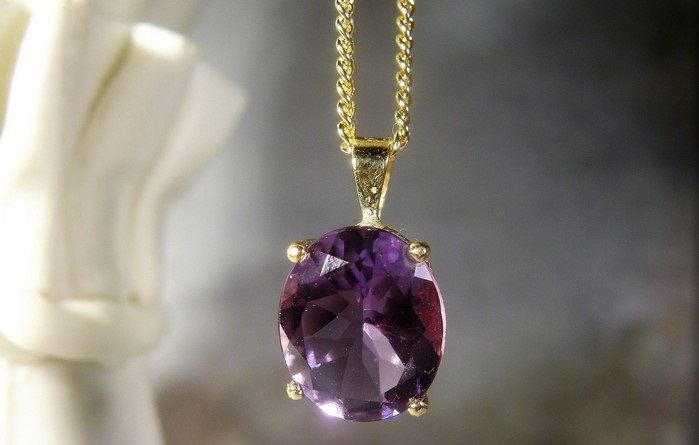Jewelry, as an adornment that has adorned human bodies for thousands of years, carries not only aesthetic value but also cultural and historical significance. Among the myriad of jewelry types, amethyst necklaces have always been favored by consumers due to their unique color and mystical aura. However, one may notice that the prices of amethyst necklaces vary greatly in the market. This article aims to explore the reasons behind the price differences of amethyst necklaces from a professional jewelry appraiser’s perspective.
Material Quality and Origin
The material quality and origin of amethyst are crucial factors influencing its price. Amethyst belongs to the quartz family and is a type of semi-precious stone. Its color ranges from light purple to deep violet, with some pieces exhibiting a unique “grape wine” hue. The purity, saturation, and transparency of the color directly affect the value of amethyst. High-quality amethyst is characterized by deep, vivid purple hues with high transparency and few impurities.
Moreover, the origin of amethyst also plays a significant role. Some mines produce amethyst with exceptional quality and clarity, making them highly sought-after in the market. For instance, amethyst from Siberia and Brazil is renowned for its purity and vivid color. These mines often have limited reserves, leading to a scarcity that further drives up prices.
Cut and Polishing Techniques
The cut and polishing of amethyst are also important factors affecting its price. A well-cut amethyst can maximize its brilliance and beauty, enhancing its overall appeal. Skilled craftsmen use precision tools and techniques to shape and polish the gemstone, ensuring that it captures and reflects light in the most captivating way.
Different cutting styles can also affect the price. For example, a round brilliant cut amethyst will typically have more facets, allowing it to sparkle more intensely. This intricate cutting process requires more time and skill, contributing to the higher price.
Clarity and Inclusions
Clarity refers to the internal purity of the gemstone, with fewer inclusions and cracks indicating higher quality. Amethyst, like many other gemstones, can contain various inclusions such as gas bubbles, liquid inclusions, and mineral crystals. These inclusions can affect the transparency and overall appearance of the gemstone.
High-clarity amethyst is rare and highly valued. Pieces with minimal or no visible inclusions are often priced significantly higher than those with numerous or prominent inclusions. Consumers who prioritize clarity will be willing to pay more for a gemstone that appears flawless.
Carat Weight
Carat weight is another important factor influencing the price of amethyst necklaces. Generally, larger gemstones are more rare and difficult to find, making them more valuable. The price of amethyst increases with its carat weight, but this relationship is not linear. Larger gemstones are often priced at a higher per-carat rate due to their scarcity and increased demand.
However, it is worth noting that the shape and cutting style of the gemstone can also affect its perceived weight and value. For example, a well-cut oval amethyst may appear larger and more impressive than a poorly cut round one of the same carat weight.
Brand and Designer Influence
The brand and designer associated with the amethyst necklace can also significantly impact its price. Well-known brands and designers often have a higher brand value and reputation, which is reflected in the pricing of their products. These brands and designers invest heavily in research and development, ensuring that their jewelry is of the highest quality and design.
Moreover, some brands and designers may use unique or proprietary cutting techniques and settings, adding to the exclusivity and value of their products. Consumers who prioritize brand recognition and designer aesthetics are often willing to pay a premium for these unique and high-quality pieces.
Market Demand and Supply
The market demand and supply dynamics also play a crucial role in determining the price of amethyst necklaces. When demand exceeds supply, prices tend to rise. Conversely, when supply exceeds demand, prices may fall.
Factors such as fashion trends, economic conditions, and consumer preferences can affect market demand. For example, if amethyst becomes trendy and widely sought-after, its price may increase due to increased demand. Similarly, if the economy is booming and consumers have more disposable income, they may be more willing to splurge on luxury items like amethyst necklaces.
Historical and Cultural Significance
The historical and cultural significance of amethyst can also influence its price. In many cultures, amethyst is believed to have mystical and healing properties. For instance, ancient Greeks believed that amethyst could protect against drunkenness and anger. This historical and cultural context adds to the allure and value of amethyst necklaces.
Pieces with historical significance or provenance, such as those that have belonged to famous individuals or have been featured in important events, may command higher prices due to their unique stories and associations.
Authentication and Certification
Authentication and certification are essential for ensuring the authenticity and quality of amethyst necklaces. Reputable gemological laboratories use advanced technology and expertise to assess the quality of gemstones, providing consumers with accurate and reliable information.
Necklaces that have been authenticated and certified by reputable laboratories often come with a certificate of authenticity or grading report. These documents provide detailed information about the gemstone’s quality, origin, and treatment history, adding to the credibility and value of the piece.
Conclusion
The price differences of amethyst necklaces are influenced by a multitude of factors, including material quality and origin, cut and polishing techniques, clarity and inclusions, carat weight, brand and designer influence, market demand and supply, historical and cultural significance, and authentication and certification. Understanding these factors can help consumers make more informed purchasing decisions and appreciate the unique value of each amethyst necklace.
Related topic:
- Discovering the Elusive Amethyst in Stardew Valley
- Is Dream Amethyst Natural?
- How Much is Green Amethyst Worth?


